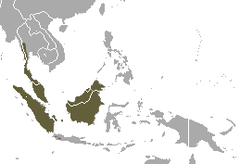Linzang pręgowany
| Prionodon linsang[1] | |||
| (Hardwicke, 1821) | |||
 | |||
| Systematyka | |||
| Domena | |||
|---|---|---|---|
| Królestwo | |||
| Typ | |||
| Podtyp | |||
| Gromada | |||
| Podgromada | |||
| Infragromada | |||
| Rząd | |||
| Podrząd | |||
| Rodzina | |||
| Rodzaj | |||
| Gatunek | linzang pręgowany | ||
| Synonimy | |||
| Podgatunki[9] | |||
| |||
| Kategoria zagrożenia (CKGZ)[10] | |||
 | |||
| Zasięg występowania | |||
(c) IUCN Red List of Threatened Species, species assessors and the authors of the spatial data., CC BY-SA 3.0 | |||
Linzang pręgowany[11] (Prionodon linsang) – gatunek drapieżnego ssaka z rodziny linzangów (Prionodontidae).
Taksonomia
Gatunek po raz pierwszy zgodnie z zasadami nazewnictwa binominalnego opisał w 1821 roku przyrodnik i oficer brytyjski Thomas Hardwicke nadając mu nazwę Viverra linsang[2]. Jako miejsce typowe odłowu holotypu Hardwicke wskazał Malakkę w Malezji[2].
Etymologia
- Prionodon: gr. πριων priōn, πριονος prionos „piła”; οδους odous, οδων odōn „ząb”[12]
- linsang: jaw. nazwa Linsang dla tego zwierzęcia[13].
- gracilis: łac. gracilis lub gracilus „smukły, elegancki, szczupły”[14].
Zasięg występowania
Linzang pręgowany występuje w zależności od podgatunku[9][15]:
- P. linsang linsang – południowa Mjanma, Półwysep Malajski, Sumatra i południowa Tajlandia.
- P. linsang gracilis – Bangka, Belitung, Borneo i Jawa.
Morfologia
Smukłe, beżowe, pasiaste zwierzę o małej głowie i spiczastym pyszczku. Długość ciała wynosi 37,9–45 cm, długość ogona 33–37,5 cm; masa ciała 590–800 g[9].
Ekologia
Żyje w lasach, aktywny nocą, zjada drobne kręgowce, larwy i owady.
Ciąża trwa dwa miesiące, rodzą się zazwyczaj dwa młode.
Przypisy
- ↑ Prionodon linsang, [w:] Integrated Taxonomic Information System [online] (ang.).
- ↑ a b c T. Hardwicke. Descriptions of the Wild Dog of Sumatra, a new Species of Viverra, and a new Species of Pheasant. „Transactions of the Linnean Society of London”. 13, s. 236, ryc. xxiv, 1822. (ang.).
- ↑ T. Horsfield: Zoological researches in Java, and the neighbouring islands. London: Printed for Kingsbury, Parbury, & Allen, 1824, s. tekst i 24. (ang.).
- ↑ R.-P. Lesson: Manuel de mammalogie, ou histoire naturelle des mammiferes. Paris: J. B. Bailliere, 1827, s. 172. (ang.).
- ↑ R.-P. Lesson: Nouveau tableau du règne animal: mammifères. Paris: A. Bertrand, 1842, s. 60. (fr.).
- ↑ W.T. Blanford. Description of two apparently new Mammals from Tenasserim. „Proceedings of the Asiatic Society of Bengal”. 1878, s. 71, 1878. (ang.).
- ↑ H.J.V. Sody. Seventeen new generic, specific, and subspecific names for Dutch Indian mammals. „Natuurkundig Tijdschrift voor Nederlandsch Indië”. 96 (1), s. 43, 1936. (ang.).
- ↑ H.J.V. Sody. Notes on some Primates, Carnivora, and the babirusa from the Indo-Malayan and Indo-Australian regions. „Treubia”. 20 (2), s. 157, 1949. (ang.).
- ↑ a b c P. Gaubert: Family Prionodontidae (Linsangs). W: D.E. Wilson & R.A. Mittermeier (redaktorzy): Handbook of the Mammals of the World. Cz. 1: Carnivores. Barcelona: Lynx Edicions, 2009, s. 172. ISBN 978-84-96553-49-1. (ang.).
- ↑ J.W. Duckworth i inni, Prionodon linsang, [w:] The IUCN Red List of Threatened Species 2016 [online], wersja 2022-1 [dostęp 2022-03-20] (ang.).
- ↑ W. Cichocki, A. Ważna, J. Cichocki, E. Rajska-Jurgiel, A. Jasiński & W. Bogdanowicz: Polskie nazewnictwo ssaków świata. Warszawa: Muzeum i Instytut Zoologii PAN, 2015, s. 141. ISBN 978-83-88147-15-9. (pol. • ang.).
- ↑ Palmer 1904 ↓, s. 562.
- ↑ Palmer 1904 ↓, s. 378.
- ↑ gracilis, [w:] The Key to Scientific Names, J.A. Jobling (red.), [w:] Birds of the World, S.M. Billerman et al. (red.), Cornell Lab of Ornithology, Ithaca [dostęp 2022-03-20] (ang.).
- ↑ C.J. Burgin, D.E. Wilson, R.A. Mittermeier, A.B. Rylands, T.E. Lacher & W. Sechrest: Illustrated Checklist of the Mammals of the World. Cz. 2: Eulipotyphla to Carnivora. Barcelona: Lynx Edicions, 2020, s. 394. ISBN 978-84-16728-35-0. (ang.).
Bibliografia
- T.S. Palmer. Index Generum Mammalium: a List of the Genera and Families of Mammals. „North American Fauna”. 23, s. 1–984, 1904. (ang.).
Media użyte na tej stronie
Autor: (of code) -xfi-, Licencja: CC BY-SA 3.0
The Wikispecies logo created by Zephram Stark based on a concept design by Jeremykemp.
Autor: Daderot, Licencja: CC0
Exhibit in the Museo Civico di Storia Naturale di Genova, Via Brigata Liguria, 9, 16121, Genoa, Italy. Photography was permitted in the museum without restriction.
(c) IUCN Red List of Threatened Species, species assessors and the authors of the spatial data., CC BY-SA 3.0
Banded Linsang (Prionodon linsang) range




